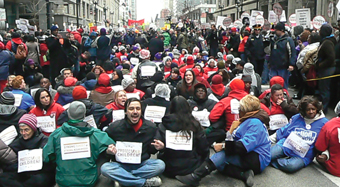Chicago Public Schools announce layoff of 2,110
By AP | Last updated: Jul 24, 2013 - 2:57:38 PMWhat's your opinion on this article?

Teachers, students and activists protested earlier this year about closure of 50 schools, now over 2,000 teachers and school staff face layoffs. Photo: La Risa Lynch
|
The Chicago Public Schools layoffs are in addition to the approximately 850 teachers and support staff who were laid off in June, which the district attributed to its planned closures of about 50 schools that it considered underutilized.
Among those laid off July 18 are 1,036 teachers, the remainder are support staff, including teacher assistants, food service employees and janitorial staff.
School district spokeswoman Becky Carroll said the district is facing a $1 billion budget deficit, much of it driven by an increase in its pension obligations.
“We were hoping to get pension reform in Springfield,” she said. “That did not happen. That has brought the pension crisis to the doorstep of our schools,” she said.
Chicago schools were seeking a waiver on pension payments for the 2014 budgetary year, which began July 1. During the spring legislative session, the General Assembly failed to pass legislation permitting the district to make a reduced pension contribution over the next two years, obligating the district to increase the contribution by $400 million.
District officials said even if pension reform is enacted by the Legislature, it would not commit to reversing the layoffs.
Chicago Teachers Union President Karen Lewis expressed surprise at the number of layoffs, saying she expected the figure to be closer to 800.
“Once again, CPS has lied to parents, employees and the public, about keeping the new school-based budget cuts away from the classroom,” Ms. Lewis said in a statement.
The district has eliminated $600 million in central office operations and administration in recent years, in addition to $52 million in cuts it made this year, according to spokesperson Carroll.
“We can’t cut our way out of this crisis,” she said. “Our spending obligations, pension, salary increases and other costs, continue to rise.”
The majority of the teachers laid off are probationary teachers who have worked for CPS for less than three years, said CPS Chief Talent Officer Alicia Winckler.
The teachers being laid off were to be notified by their principals on July 19. Ms. Winckler said all laid-off teachers will be able to reapply for district teaching positions. She noted that in the past, more the 60 percent of district teachers who were laid off were rehired.
The announcement came as lawyers for the nation’s third-largest school district were in a federal courtroom defending Chicago’s plan to shutter some 50 schools.
The Chicago Teachers Union and concerned parents who are seeking an injunction to halt the plan before the new school year begins say the closures inordinately harm Black and special-needs students, violating their rights.
The hearing stems from several lawsuits filed on behalf of parents. One contends that Black children make up about 88 percent of students being moved from closed schools, although they comprise 42 percent of district students.
Critics say talk by city and school officials of budgetary savings is misleading, leaving the impression that the closures will help address the yawning budget deficit. Pressed during cross-examination July 18, which was the hearing’s third day, CPS’ budget director, Ginger Ostro, conceded that the closures weren’t designed to fix CPS’ financial mess.
Adam Anderson, a district planning official, testified that what guided the district as it decided what schools would be closed was how much classroom space wasn’t being used.
A complex “utilization equation” was employed in the process, and the district found there were some 500,000 available classroom seats for 400,000 students, leaving 100,000 seats unused, Mr. Anderson said.
Enrollment has fallen over the years with a corresponding fall in population in Black areas, which is why so many of the schools that ended up on the closure list were in predominantly Black neighborhoods, Mr. Anderson said. (AP)
INSIDE STORIES AND REVIEWS
-
-
About Harriett ... and the Negro Hollywood Road Show
By Rabiah Muhammad, Guest Columnist » Full Story -
Skepticism greets Jay-Z, NFL talk of inspiring change
By Bryan 18X Crawford and Richard B. Muhammad The Final Call Newspaper @TheFinalCall » Full Story -
The painful problem of Black girls and suicide
By Charlene Muhammad -National Correspondent- » Full Story -
Exploitation of Innocence - Report: Perceptions, policies hurting Black girls
By Charlene Muhammad -National Correspondent- » Full Story -
Big Ballin: Big ideas fuel a father’s Big Baller Brand and brash business sense
By Bryan Crawford -Contributing Writer- » Full Story






 Click Here Stay Connected!
Click Here Stay Connected!








